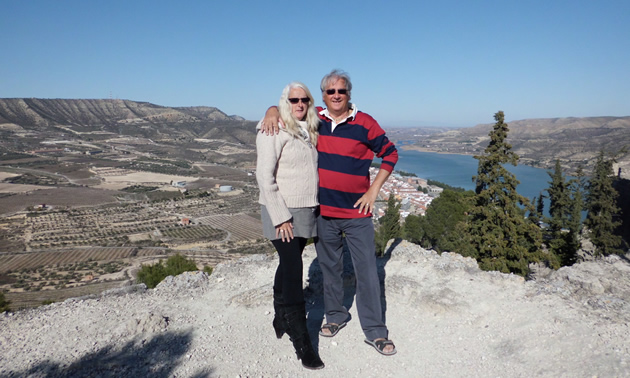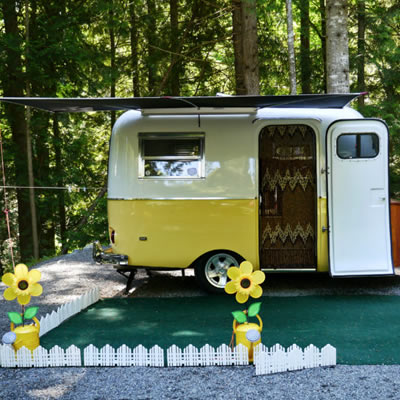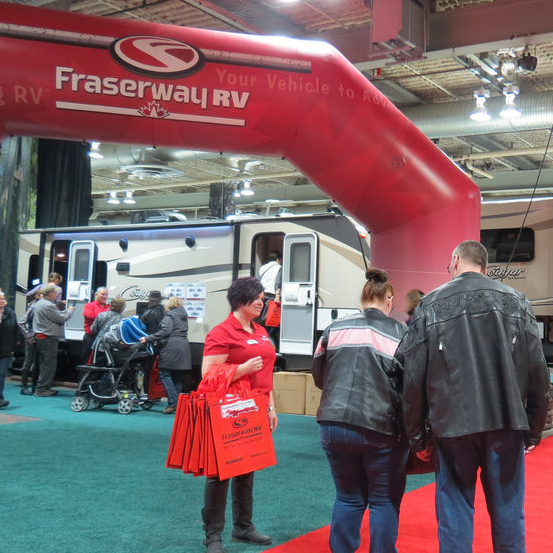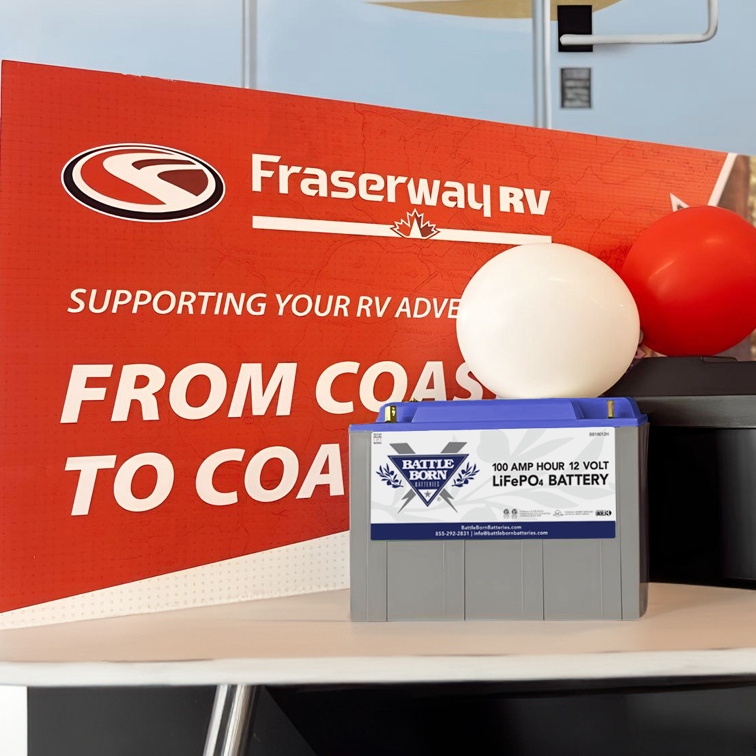From Norfolk to Gibraltar in a motorhome
Bill, Bonny and Scamps the cat head south in search of sun and fun

If you have ever had the yearning to explore Europe in a motorhome but did not know how to do it, the following information could be just what you need to bite the bullet.
This article chronicles our three-month adventure around Europe: places we visited as well as travel information to help you get there and back.
Before we could start our trip, my wife Bonny and I and the Scamps the cat had to get many things sorted first. What would we need? Never having done this before, it was difficult to know where to begin. So we started with passports. Bonny and I had passports, but the cat did not. So armed with information off the Internet we took Scamps to the vet for her passport. She had to have a few injections and a blood test. It would take four weeks before we would know if she could have a passport.
She had identification chips inserted in the back of her neck, under her skin, with a unique number on it. This is checked with a scanner at passport control to confirm that she is the same cat on the passport. The chip can only be removed by a vet. A photo can also be added to the passport if you wish.
On the way to the vet, Scamps screamed and made a mess on the carpet. The smell was awful. She did not like travelling. Bonny and I began to wonder if it was a good idea taking her with us. Kids do not make the noise she did in the car. And of course, me being the driver, it does get to you, a screaming cat in the back of the car. Anyway, we decided she will have to come with us and get used to travelling, as we don’t want to put her in a cattery.
Passports sorted, we needed to sort what clothes we were going to need, as we were leaving December 22. Do we need warm clothes or summer? Not sure, as we are going south down through France, Spain, Portugal, Gibraltar and back up the west coast of Spain.
We decided we needed a bit of both. Scamps is OK; she has a fur coat to keep her warm should the need be.
Clothes sorted, food sorted. We purchased a small 12-volt freezer for frozen meat, etc.
It was now time to look at how we wanted to cross the English Channel. There are two ways: you can go across the water by ferry or under the water on a train in the Eurotunnel. We don’t like the sea, so we decided to travel on the train. It is drive on and drive off at the other end in France. The cost for this is £49 each way. This included Bonny and I, but not Scamps. I had to pay £30 return for her. If I had two other passengers in the motorhome it would have still only cost £49 each way, but a cat is an extra £30.
We did not make a plan as to where we were going to stop on our trip. We armed ourselves with two sat navs [GPS devices]. One sat nav has campsites built into its software.
We also took a few books that direct you to campsites. The first is Camping Card ACSI. If you buy a membership for £18, you are given a CC card with all your passport information on it, so when you stop at a campsite you do not have to leave your passport with them. You also get discounts on daily or weekly stays. The average price, which includes discount, is 12, 14 or 16 euros. The ACSI book lists over 1284 campsites in France, Portugal and Spain and 1017 in the rest of Europe
Next comes the Aires de Service France book for £17.99. Aires France has over two thousand 24- to 48-hour stopovers. You find them all over France. Aires offer convenience and freedom from campsites. Motorhome stops can have riverside views of the Rhine at a vineyard complete with free tours and tastings. There are even Aires alongside the Canal di Midi towpath.
Perhaps you want stay right next to the Mediterranean or other places where there are simply no caravan sites. Many of the Aires in France, Germany and Italy are municipally provided and are located near the local town and amenities, so additional transport is not needed. Motorhome stops are generally exceedingly cheap or free. The idea is that motorhome travellers will shop in the town or village and also visit the local tourist attractions and restaurants.
Aires in Spain and Portugal were nowhere near as good as France, but still very useful on the road for one or two nights’ stopover. Most of these are free. Some have services, some are just a parking area.
France Passion is a book you buy for £25 that gives you over 1500 stopovers. All are free. The places it lists are vineyards, restaurants, farms or houses with large areas where you can park. The wineries, etc., would like you to purchase some of their produce while you stay there, but this is not compulsory. But who would not want to purchase some wine or farm produce when it is fresh and half the price in the shops? The restaurants that allow you to park in their car parks would also wish you to have lunch or dinner there, but this is also not compulsory.
All the above books have some sort of directions on how to reach these places when you are on the road.
We started our trip from our home in Welney, a lovely part of England very near Cambridge. We drove down to the Eurotunnel with Scamps complaining all the way. We had to drive through the Dartford tunnel, which cost us £1.50 for the motorhome. After we got through it we set the sat nav for no toll roads, as the cost of tolls in Europe are very expensive. If we had done this before the Dartford tunnel it would have given us a two-hour detour and £1.50 is a small price to pay.
After three hours of driving we arrived at the Eurotunnel. We had done this many times before in the car, so we knew what we had to do. There are plenty of cafes and shops where you can spend your money and have a good walk around.
Crossing on the tunnel Folkestone to Calais only takes 35 minutes. You drive on the train, sit in your vehicle and drive off at the other end. Remember to drive on the opposite side of the road when you arrive.
The plan was to drive to our holiday house in Confolens in the Charente area and stay for Christmas. We started our trip in Calais. We stayed the night in the shopping mall car park and got up for an early start, as we had 550 miles to drive through Rouen. By this time Scamps was hiding under the duvet and not coming out for anybody, which was great because she did seem to be settling down a bit. On to Evreux, Tours and Poitiers and then into Confolens some ten hours later. Arriving at our place in France we had to open everything up in the house and also get Scamps out of the motorhome and into the house, as she had not been here before. After having a good look around she settled in nicely.
We travelled 550 miles, getting a average of 30 miles to the gallon doing a speed average of 60 mph. The price of fuel in France is 1.35 euros. lt cost 93 euros to fill the fuel tank.
We had a great time over Christmas with the log fire. Scamps had never see a log fire before, so she decided to spread herself right across in front of it. I think she felt it was the only way to stay warm, as temperatures dropped down to -21 C. This is not normal for France in November. Early December was 19 to 21 C.
On January 6 we started our trip down south to the border of France and Spain. For our first night’s stop we hoped the temperatures would be better. We checked our Aires book, as we were only staying for one night. The best stop we could see near the border was St Jean de Luz. Upon arriving we were shocked to find all the 20 parking spaces full. We really did not expect this, as it was early January. By this time it was getting late evening. We looked at the book again and saw another place some 10 miles away in Hendaye. This stopover is a railway station. When we arrived there was just one place left, so we parked up for the night. In the book it tells you how many motorhomes can stop overnight, so it is handy to know this. Scamps was now settling down, but still hiding under the covers.
We made an early start next morning to make for the Spanish border. The French Aires book was put away and we got out the Spain and Portugal Aires and made our way down though Spain. As I am a dedicated fisherman, the plan was to look for a river or lake in the Aires book. We found a free stop on the river bank at Mirenda de Ebro after a four-hour drive. We found this to be a very nice place. We were able to park alongside the river and only a short walk into the town center. What a great town! There were plenty of shops--just what we needed to top up our groceries.
The weather was still very cold, as it was only the second week in January. We just stayed overnight and then made our way to the historical town of Burgos, where we found a campsite in the ACSI book. We felt it was time to spend a few nights with electricity. This helps to keep the freezer down to -19 C and keep the meat frozen.
The campsite was very quiet, so Scamps could have a good wander on her own. Off she went and came back in about half an hour. We did see her walking all over the sinks in the washroom and going inside awnings of fellow campers. This is really good news. She is better than a dog--no leads. We just let her out and back she comes.
We met a nice couple from Wales and we had a very good dinner in the restaurant. I must say that Castilla Y Leon is a very nice site at a cost of 15 euros a night. In Burgos there is a cathedral that is world famous; it is a must for any visitors.
We were now making our way to northern Portugal, but we were going to need an overnight stop. The best one is the Aires. It is by a lake and close to the town of Rua De Valdoerras. We put in the map reference and it took us there. The parking is in the community sports facility car park.
What a lovely place this is. The lake was just beautiful. We had a added bonus, as there was a café there. It did not tell us this in the book. We had a real rubbish meal there, but it did not matter as the place was so nice and the beer was good. Log fire--what more could you want? There was also a very old VW camper and two hippies in the car park. You would have thought your were in the mid-1960s.
We decided we needed to have another couple of nights with electricity, so the Aires book did it again. We found this place called Noguero. It is a mini campsite at a riding stables, complete with hot showers, barbecue and laundry area, all for 10 euros a night.
On the way there we passed a place called Ourense. It had to be the most up-to-date city I have seen in Spain. It had some really 23rd-century buildings.
A maximum of nine motorhomes are allowed here, but when we arrived there was not even one; we had the place to ourselves. We went to plug in the electricity, but the Spanish plug is different to the French plug. They look the same, but I tell you they aren’t. Big problem now. I walked up to the stables to try and find somebody. I found this guy seeing to the horses, but he did not speak any English at all. Can you imagine me trying to explain about the plug problem? I got through to him by going to the plug on the wall in the stables and pointing hand signs. After a great deal of hand movement, he found me an extension, which worked well. I offered to pay, but he told me by pointing to just eave it before I leave. What a godsend. We had -15 C that night. The heating was on full and we woke up to everything white in the morning.
By the way, I forgot to say Scamps sleeps on the bed with us and the bed is really only for two, not two and a cat who likes to sleep horizontal. Bonny complains the cat has more room than her in bed. It’s only because Scamps sleeps on my side that she is complaining.
We had two really cold nights of -15 and decided it was time we started moving south as soon as possible. Because we were travelling out of season there was nobody to take our 20 euros for the two nights we spent there.
Just as we were leaving, the guy from the stables came down to clean the shower rooms. Knowing that we were travelling through Spain and Portugal and needed this power lead, I just did not want to give it up. So I called him over opened the storage compartment, put in the lead, then took it out, looked at him, put it back in and he just looked at me and shrugged his shoulder. So I put it back in the storage, gave him 10 euros and drove off. I was feeling very pleased with myself as my lead problem had now gone away.
We were on our way to northern Portugal January 17, hoping it was going to get warmer. We arrived at a place called Caminha, 1,468 miles away from our home in the U.K. This is a very nice part of northern Portugal, on the coast and by a lovely town. The only problem was the mile walk into town. The price was 30 euros for the two-night stay. As it was still cold in Portugal, it was time to start pushing further south. We couldn’t wait to get some sun. We passed Porto and headed down into St Jancinto. We drove all along the coast road. The sightseeing was really nice, with so much wildlife.
Arriving at the campsite we chose, we had a problem. The book told us it was open 12 months a year, but it was closed. It was also getting late. We drove further down the road and we were very lucky. About one mile down the road we found a campsite open. This was a very big site, but we were the only ones there. We asked the manager about dinner in the restaurant and he was kind enough to open it for us. We arrived for dinner at 7 o’clock and the table was all laid out for us. What a nice surprise! The food was great: two bottles of wine, soup, steak and chips and dessert was 20 euros the lot for the both of us. So we gave him a 5 euros tip because you could not fault anything.
The next day we had a great walk along the river. As the weather was now getting warmer, it was time to find a campsite where I could do some fishing and stay for a week. So we made our way further south. We drove for about 10 miles along the river following the sat nav and we came to a dead end. In front of us was the river. The only way across was a ferry, as the river is about one mile across. We waited for about half an hour until we could see the ferry as it was getting closer. I didn’t think we would be able to get on it, as the ferry dock was very small. Nobody spoke English. I had to find the captain. I fetched him to our motorhome. He looked and said “No, no, no, no fit.” The only way back was 60 miles down the side of the river, going past the site we stayed at.
We got to the first bridge and over we went to the next stop at Montargil/Ponte. This campsite is next to a large lake. The temperature was about 11 C now. The site was open but we again were the only ones there. We could park anywhere we liked, but it has got to be by the lake. In Portugal you have to have a license to fish. It took me over five hours to sort this, but I did get one after the manager of the site took me to a government building some 30 miles away.
I fished for three days, but no fish. The water was still very cold. Most things on the campsite were still closed, as we were still very early in the season. Scamps had company there, as there were five cats that surrounded us most of the time we were there.
Moving on south to another site, also on a very large lake, was Markadia. This was a very open site with plenty of trees, nice little parking areas for the motorhome to park. All sites have electricity, so we chose a nice little spot right by the lake. The water level was very low, as there had been no rain for months. This was a lovely place with rabbits running about all over the place with Scamps right behind them. This site was 20 euros a night, but if you stop for one month they only charge you for two weeks in their off-season. We met some nice people there. As we have now moved south we have found a lot of English people staying there for the winter to get away from the cold weather in England.
We had been having a bit of a problem with the water pump on the motorhome, so the plan was to make our way down to Faro, the most southern part of Portugal. There is a Aires stop that is a motorhome sales place and you can stop overnight free, so the idea was to stop, get the water pump fixed and move on to a campsite the next day to Quarteria. The book told us the sales place was on the coast road. We arrived at the place where it is supposed to be and we found it had closed down. What a bummer.
Luckily we were not too far from the campsite where we were going to stop for a week or two in Quarteria. This campsite is on the Algarve. It is very busy, as it is as far south as you can get in Portugal. The Germans, Dutch and English all seem to have their own part of the park. It is very funny to us. As we have never done this before, we just parked where there was an empty space. As it happened, it was on the English side. The campsite was nice, but the people . . . well, they come down every year and we found them not very friendly.
We had now travelled 2,080 miles from home and were starting to get a bit of a tan, which was great. After three days we decided to move on. After visiting the weekly market, we started on our way to Gibraltar, moving along the south coast and staying at a camp Roche. This campsite was very nice and also full of different nationalities. We meet a very friendly English couple that were over from Australia on a three-month holiday. They were towing a caravan: good idea, as they just unhitch the car. They invited us to visit a very old town called Medina Sidonia. It had a historic church right on top of a mountain. If you are ever going that way you must stop here.








